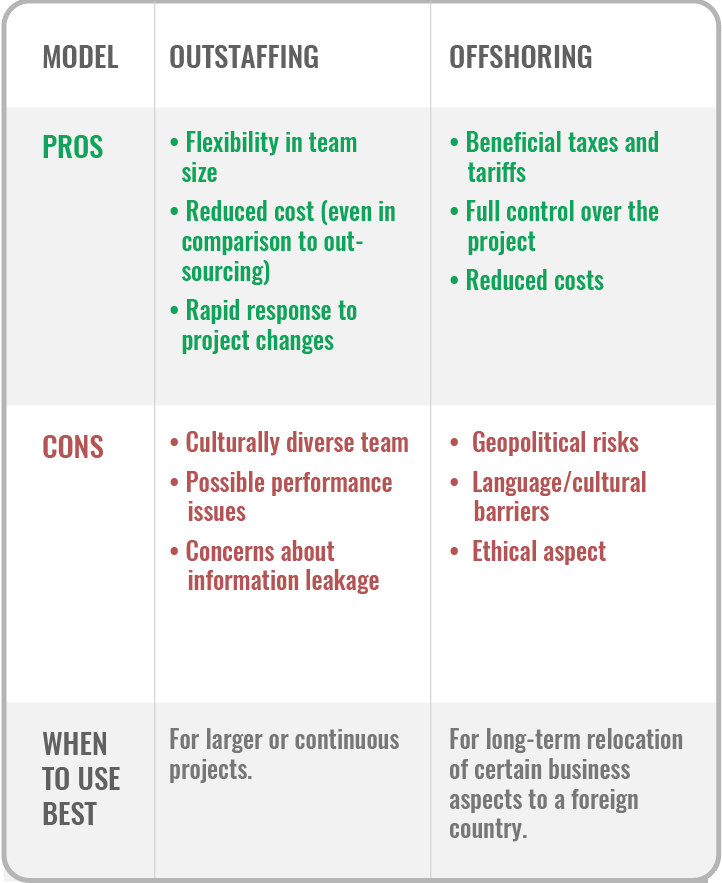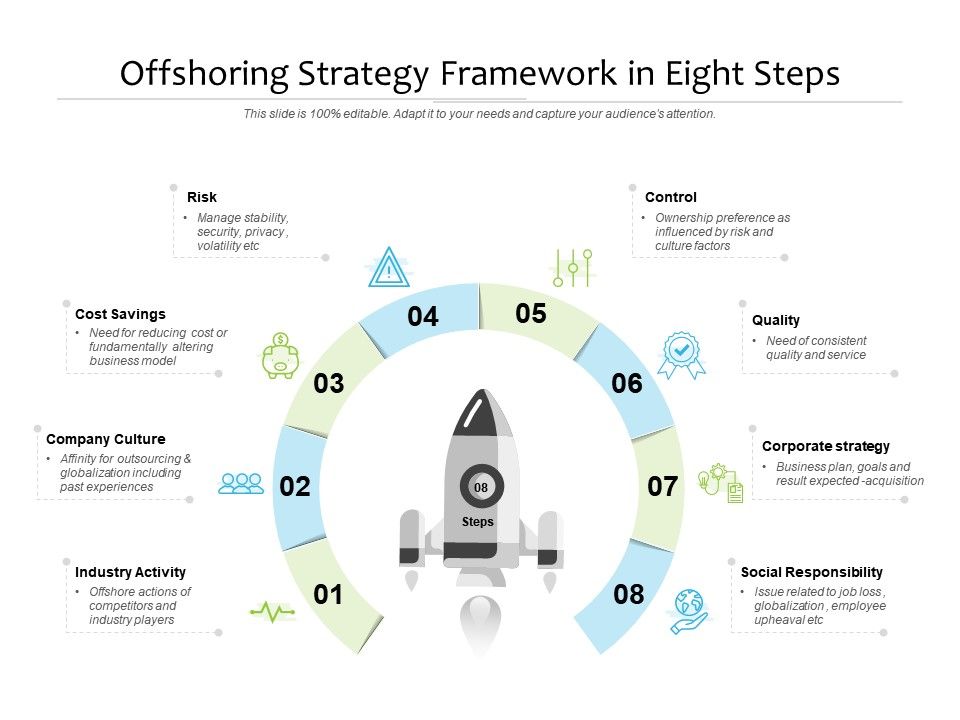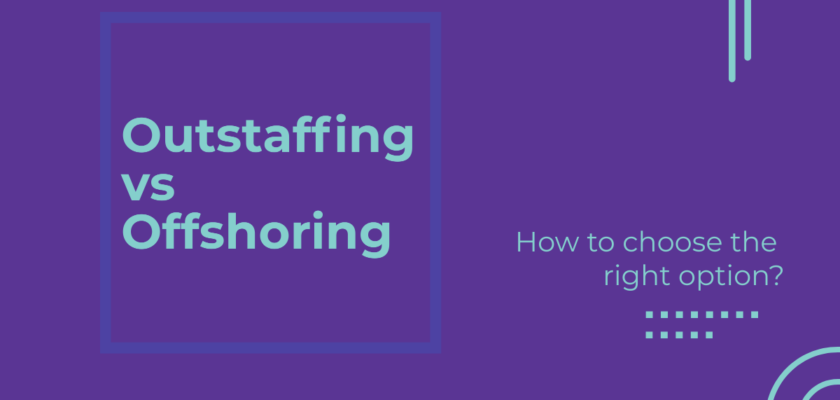It has been noticed that the number of software developers is getting lower, meanwhile, the number of tech specialists is growing and they are more in demand on the market than software developers. Many enterprises keep seeking help from external resources. Consequently, two terms like “outstaffing” and “offshoring” have become very useful.
What is the difference between outstaffing and offshoring? These two terms, even though, have close meanings, are quite different. Offshoring refers to a specific location abroad. Outstaffing refers to some delegation mode that is not connected with physical distance.
Offshoring means the engagement of specialists from abroad. It might be your own company’s specialists or those who are hired by the service provider to fulfill specific tasks.
A decade ago, it was the company’s goal to cut the costs, consequently, cut the salaries too in the row with reduced taxes and decreased maintenance costs. All the previously mentioned reasons motivated companies to go abroad. Currently, tech companies started searching for talents abroad regarding the lack of experienced and skillful employees inside their country.
American markets need tech specialists. And software companies are struggling to find such specialists. American software companies are lacking skillful engineers. Regarding the APP Association, there are around a quarter-million software developer vacancies open in the US. And there are around 62,000 computer science students who are graduating from universities and joining the working force every year. That’s why tech companies are coming across very serious difficulties with the employment process even though they can offer good salaries.
Meanwhile, there are countries, like Ukraine, which are the home for very experienced and skillful software developers. They are also a comparatively cheap working force which is growing every year, and Ukraine is a country with comparatively low costs in general. There are also some more facts on why Ukraine is a good country for hiring an offshore development team and for dealing in the business sense as well.
- Ukraine stays among the top 20 offshore locations in EMEA (Gartner) and among 25 IT service exports (PwC).
- Ukraine is a tech hub that contains 220K of IT professionals and every year these numbers are getting higher.
- Ukrainian specialists take 5th place in the world for their professionalism.
- Ukraine has a comparatively cheap working force.
- Developers in Ukraine are oriented to long-term cooperation. They have a good level of English and are culturally close to the West.
- According to the rating of the independent resource Kearney, Ukraine is 20th in the top of all countries that provide outsourcing services and has already won the trust of companies like Google, Samsung, Microsoft, Snap, Crytek, SoftServe, Ubisoft, Oracle, and others.
- There are startups in Ukraine that have appeared recently: Revolut, Preply, Reface, Very Good Security, Propertymate, Elision, 3DLook, etc.
Many companies relocate their activities to distant places to reduce the talent gap. offshoring and outstaffing models are getting popular. They settle branches and launch manufactures abroad. When any enterprise decides to move offshore, it can do everything on its own or hire a vendor who will settle everything for the head company.
It is reasonable to involve a vendor only for non-core business activities. It is possible to open a software development office in a different country and receive back-office support from the operational management provider. Following this plan, you can stay concentrated on your product, meanwhile, the local vendor will take care of all the operations for the company.
Talking about offshoring, it is necessary to mention onshoring and nearshoring. Onshoring (inside the country) allows companies to give tasks to vendors in the same country. There are some financial benefits under onshoring options. Nearshoring provides opportunities to delegate tasks to another country. However, for nearshoring, companies choose nearby countries.
Outstaffing is having different meanings. It is mostly about delegating tasks to external professionals in the country or abroad. The main goal here is also to increase human resource flexibility by engaging more talents. Outstaffing is a good way to have a one-time task completed and not to attract a new person. Vendors are usually hired to create a special result from the beginning to the end. Having the outstaffing model, the client does not care that much who specifically will perform the task, he is only interested in the result and the duties’ delegation.
Vendor needs a project, he has a team and gives workplaces and all the necessary staff, like equipment, rewards, HR activities. The provider also manages all the tasks. His employees fulfill the project as it is agreed upon and provide results to the client. All communications happen via a project manager.
For example, if you have some business and this business needs an app and you do not have the necessary knowledge in some sphere, outstaffing software development team will be a good solution. However, in case your company has appeared not that long ago and you are just a startup, the product you are creating is your core business, outstaffing might not be the reasonable option, and the best thing will be to search for the different business model.
There is an outstaffing vs offshore difference that is in the main goal and location. based on the results which you want to have in business, you need to pay attention to the special points. They are aim, location, activities, cultural specifics, political undertones.
First is aim.
If we keep considering the case with software tech companies, offshoring is a good way to obtain talented software developers who are being very required on the market.
Outstaffing some business functions, you have an opportunity to focus on the main parts and reach some short-term goals. However, there are some drawbacks in the outstaffing model like the missing part of specialized expertise, but it is a good solution to the high expenses of in-house employees.
In general, both models are aimed at reducing expenses.
The second essential criteria is location.
Offshoring is the decision to go abroad and find a foreign skillful workforce. At the same time, outstaffing can be realized only inside one country that means the geographic proximity.
The next essential thing is activity.
Offshoring considers relocation of the whole business processes to a different country. That might be different business processes, like opening a software development center, etc. Outstaffing considers delegating non-core works that shall be fully completed.
Cultural specifics also play the vital role.
Not every startup is able to deal with a big diversity in time zones or work ethics, the situation here may affect the effectiveness of the whole business. Values might clash while offshoring to a foreign culture. Outstaffing here has an advantage as it takes place in your home country and there will not be any problem with coming across cultural differences.
One more factor to consider is the political situation in the country.
New working places are created in different country meaning that some political undertones might take place in the offshore’s functioning. However, in case the country has a good reputation for investments, political issues will not be the matter for concerns. Eastern Europe (especially Ukraine) has reliable tax regimes, good for digitalisation, has strong IT professionals who take affordable wages for their job. Outstaffing is not influenced but politics because new jobs are created inside the country.
Based on the facts, mentioned above, we can conclude that:

Offshoring vs Outsourcing has some pros and cons.
Staying with the example of software companies, the offshore type let software companies keep an eye on the development of the product. At some point, it is better for them to attract skillful engineers as the developers are willing to work for product tech companies as in that way they feel involved in the business. Moreover, if a company follows the offshoring model, it can open new markets and launch its own brand in an absolutely new country.

Among the common advantages of outstaffing vs offshoring there is cost optimization and access to the extra workforce.
Intellectual property can be very vulnerable, that’s why software companies sometimes have concerns about delegating tasks to the third parties. Sometimes it is not enough to sign non-disclosure agreements, there also might be a weak system of IP rights protection. Thats a common reason of leaks or cybersecurity breaches). Thats why, it is better to have a core business in-house without taking external providers.
Operational management is often a disadvantage for offshoring. This function is very hard to fulfill in the new environment. Often software companies prefer the local providers to do all that. So companies can concentrate on product development and main operations which are held in the core office.
To sum up, the main difference between offshoring and outstaffing is in the location and management style. In case you do not want to trust your business to the different person, it would be better to choose the different models like opening offshore development centers (ODC).
There are staffing agencies in Ukraine that help to create offshore development centers. The most trusted one is DNA325. DNA325 can help you to establish a very effective offshore development center. The company spent 10+ years in IT recruiting and related services. If you are going to organize the ODC center, the agency helps you with that. DNA325 will assist you with all steps of ODC creation. The agency can provide your business with different services: legal support, office facilities, recruit the best suitable people (create the ODC team) that fit your corporate culture, accounting, administrative services, office management.



